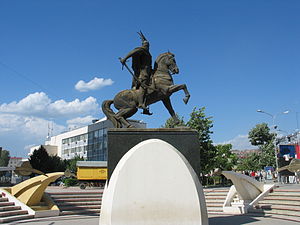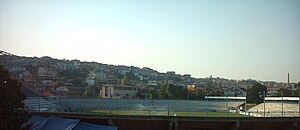This is an old revision of this page, as edited by C-c-c-c (talk | contribs) at 16:43, 4 June 2006 (removing simple vandalism). The present address (URL) is a permanent link to this revision, which may differ significantly from the current revision.
Revision as of 16:43, 4 June 2006 by C-c-c-c (talk | contribs) (removing simple vandalism)(diff) ← Previous revision | Latest revision (diff) | Newer revision → (diff)Prishtinë or Prishtina (Albanian) or Priština/Приштина (Serbian) or Priştine (Turkish), the largest and capital city of the province of Kosovo, a United Nations-administered territory. It is located at 42°40′N 21°10′E / 42.667°N 21.167°E / 42.667; 21.167. It is estimated that the current population is as high as 500,000. The city has a majority Albanian population, alongside other smaller communities including Serbs, Bosniaks, Roma and others. The territory's interim government and the United Nations Interim Administration Mission in Kosovo (UNMIK) have their headquarters in the city. It is the administrative, educational, cultural center of Kosovo. The city is home to the University of Priština and has an international airport, Priština International Airport, with the IATA airport code of PRN and ICAO code LYPR (temporarily BKPR while UNMIK in effect).
Inhabitants of Priština are called "Prishtinali" or "Prishtinas" in Albanian.
History
Early history
In Roman times a large town called Ulpiana existed 15 kilometres (9 miles) to the south of modern-day Priština. This city was destroyed but was restored by the Emperor Justinian. Today the town of Lypjan stands on the site of the Roman city, and remains of the old city can still be seen.
After the fall of Rome, Priština grew from the ruins of the former Roman city. The city was located at a junction of roads leading in all directions throughout the Balkan peninsula. For this reason Priština rose to become an important trading centre on the main trade routes across south-eastern Europe.
Priština came to be of great importance to the medieval Serbian state, and served as the capital of King Milutin (1282-1321) and other Serbian rulers from the Nemanjic and Brankovic dynasties until the Battle of Kosovo in 1389, when an invading Ottoman army decisively defeated the Balkans coalition army. The whole of Serbia was subsequently conquered by the Ottoman Empire in 1459.
The oldest Albanian writer Pjeter Bogdani came from Priština. He published his book Qeta e Profeteve (The Band of Prophets) in 1555. During the Ottoman Empire, Priština became increasingly Ottoman in character following the conversion to Islam of many of its inhabitants, both Albanian and Slav.
From the 1870s onwards Albanians in the region formed the League of Prizren to resist Ottoman rule, and a provisional government was formed in 1881. In 1912 Kosovo was briefly included in the newly independent state of Albania. But the following year the Great Powers forced Albania to cede the region to Serbia. In 1918 Kosovo became a part of the newly formed Yugoslavia, though without any of the autonomy that the region later enjoyed.
Before the Second World War, Priština was an ethnically mixed town with large communities of Albanians and Serbs. Many Albanians were deported during to Turkey in consequence of ethnic cleaning program applied by the Serbs. Muslim Albanians were identified as Turks and thus forcibly evicted from their ancestors’ homes. Albanians were sent to Turkey, where the Turkish government enforced them to accept new Turkish names and settle the Turkish provinces formerly inhabited by Greeks and Armenians.
The Second World War saw the decline of Priština's Serbian community as well as a large-scale settling of Albanians in the town. Between 1941 and 1945 Priština was incorporated into the Italian-occupied Greater Albania.

Priština after World War II
In 1946, Priština became the capital of the Socialist Autonomous Region of Kosovo. Between 1953 and 1999, the population increased from around 24,000 to over 300,000. All of the national communities of the city increased over this period, but the greatest increase was among the Albanian population, a large number of whom had moved from rural areas to settle in the city. The Albanian population increased from around 9,000 in 1953 to nearly 76,000 in 1981. The Serbian and Montenegrin population increased too but by a far more modest number, from just under 8,000 in 1953 to around 21,000 by 1981. By the start of the 1980s, Albanians constituted over 70% of the city's population.
Although Kosovo was under the rule of local Albanian members of the Communist Party, economic decline and political instability in the late 1960s and at the start of the 1980s led to outbreaks of nationalist unrest. In November 1968, student demonstrations and riots in Belgrade spread to Priština, but were put down by the Yugoslav security forces. Some of the demands of the students were nonetheless met by the Tito government, including the establishment in 1970 of Priština University as an independent institution. This ended a long period when the institution had been run as an outpost of Belgrade University and gave a major boost to Albanian-language education and culture in Kosovo. The Albanians were also allowed to use the Albanian flag.
In March 1981, students at Priština University rioted over poor food in their university canteen. This seemingly trivial dispute rapidly spread throughout Kosovo and took on the character of a national revolt, with massive popular demonstrations in Priština and other Kosovan towns. The Communist Yugoslav presidency quelled the disturbances by sending in riot police and the army and proclaiming a state of emergency, with several people being killed in clashes and thousands subsequently being imprisoned or disciplined.

Priština in the Kosovo War and afterwards
Following the reduction of Kosovo's autonomy by Serbian President Slobodan Milošević in 1990, a harshly repressive regime was imposed throughout Kosovo by the Serbian government with Albanians largely being purged from state industries and institutions. Priština University was seen as a hotbed of Albanian nationalism and was duly purged: 800 lecturers were sacked and 22,500 of the 23,000 students expelled. In response, the Kosovo Albanians set up a "shadow government" under the authority of the Democratic League of Kosovo (LDK), led by the writer Ibrahim Rugova. Although the city was formally controlled by Serbs appointed by the Miloshević government, the LDK established parallel structures, funded by private contributions, to provide free services such as health care and education that were largely denied to the Albanian population.
The LDK's role meant that when the Kosovo Liberation Army began to attack Serbian and Yugoslav forces from 1996 onwards, Priština remained largely calm until the outbreak of the Kosovo War in March 1999. The city was placed under a state of emergency at the end of March and large areas were sealed off. After NATO began air strikes against Yugoslavia on March 24, 1999, widespread violence broke out in Priština. Serbian and Yugoslav forces shelled several districts and, in conjunction with paramilitaries, conducted large-scale expulsions of ethnic Albanians accompanied by widespread looting. Many of those expelled were directed onto trains apparently brought to Priština's main station for the express purpose of taking them to the border of the Republic of Macedonia, where they were forced into exile. The United States Department of State estimated in May 1999 that between 100,000-120,000 people had been driven out of Priština by government forces and paramilitaries.
Several strategic targets in Priština were attacked by NATO during the war, but physical damage appears to have largely been restricted to a few specific neighborhoods shelled by Yugoslav security forces. At the end of the war, most of the city's 40,000 Serbs fled. The few who remained were subjected to harassment and violence in revenge by Albanian gangs, which reduced Priština's Serb population still further. Other national groups accused of collaboration with the Serbian war effort by Albanians – notably the Roma – were also driven out. According to the United Nations High Commissioner for Refugees, by August 1999 fewer than 2,000 Serbs were left in the city. The number reportedly fell even further after the March 2004 unrest in Kosovo.

Demographics
See also: Demographic history of Prishtina
According to the last census in 1991, the population of the Priština municipality was 199,654, including 77.63% Albanians, 15.43% Serbs and Montenegrins, 1.72% Muslims by nationality, and others.
In 2004 it was estimated that the population exceeded half a million and Albanians form around 98% of it. The Serbian population in the city has been reducing significantly since 1999. According to the Guardian, this is because "entire blocks of flats may be cleared by ethnic Albanian gangs, who first force Serbs to sign documents transferring ownership of their homes."
| Demographics | |||||||||
| Year | Albanians | % | Serbs | % | Roma | % | Others | % | Total |
|---|---|---|---|---|---|---|---|---|---|
| Unreliable 1991 census | 161,314 | 78.7 | 27,293 | 13.3 | 6,625 | 3.2 | 9,861 | 4.8 | 205,093 |
| 1998 | N/A | N/A | N/A | N/A | N/A | N/A | N/A | N/A | 225,388 |
| February 2000 estimate | 550,000 | 97.4 | 12,000 | 2.2 | 1,000 | 0.1 | 1,800 | 0.3 | 564,800 |
| Source: 1991 figures from Federal Republic of Yugoslavia (FRY) Institute for Statistics – others include Montenegrins, Slav Muslims, Turks, etc. 1999 figures from UNHCR, "Kosovo Village List", 9 March 1999 (1998 population estimate excluding forced displacement). 2001 figures from KFOR – MNB (c) and for minority figures
OSCE/UNHCR ‘Situation of Ethic Minorities in Kosovo’, February 2001. It is noted that the 1991 census was highly politicised and is thus unreliable. | |||||||||
See also
References and links
- Erasing History: Ethnic Cleansing in Kosovo - US Department of State, May 1999
- The official website of the Municipality of Priština
- Template:Wikitravelpar
- University of Priština
- Roman Ruins at Ulpiana 2005
- Priština Airport
- Human Rights in Kosovo: As Seen, As Told (Volume I, October 1998 - June 1999) - OSCE, 1999
- Human Rights in Kosovo: As Seen, As Told (Volume II, June - September 1999) - OSCE, 1999
- "Pristina's Serbs flee in thousands", The Guardian, August 12, 1999
| Municipalities of Kosovo | ||
|---|---|---|
| District of Ferizaj |  | |
| District of Gjakova | ||
| District of Gjilan | ||
| District of Mitrovica | ||
| District of Peja | ||
| District of Pristina | ||
| District of Prizren | ||
- http://www.guardian.co.uk/international/story/0,,283575,00.html News story by the Guardian on the Serb Exodus